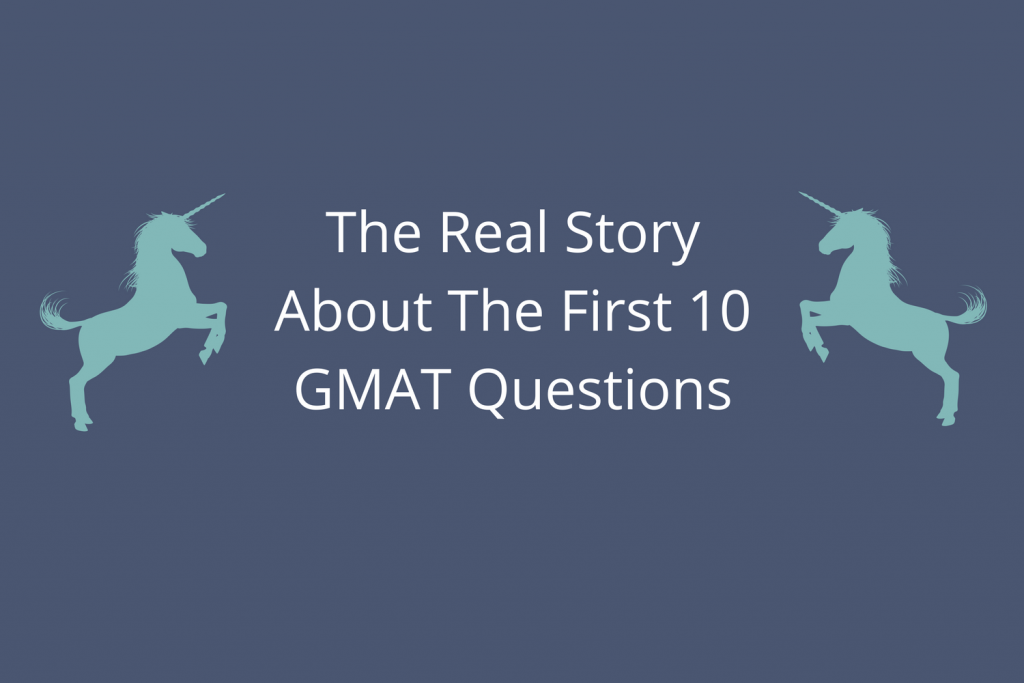CAT and Mouse
There’s a common misconception almost everyone taking the GMAT takes with them into the test.
Everyone knows the GMAT is different from other standardized tests in that it uses an intricate Computer-Adaptive Test algorithm. Gone are the days of the paper-and-pencil SAT. The GMAT not only has you looking at a computer screen for over four hours. It also has a structure that adapts to the test taker as s/he goes.
This personalizes the test for everyone taking it, but in doing so it brings unique, individualized challenges. This is very different from the more straightforward standardized tests most people are used to, like the SAT, the ACT, or even other grad-school exams like the LSAT, where the terms are transparent and the same for everyone.
The GMAT, on the other hand, exists in constant negotiation with the test taker. This can be hard to wrap your head around, and the GMAT’s unique CAT structure has created a lot of confusion in the minds of potential test-takers, and has kept many from developing an effective strategy. In order to reach your best possible score, you think of the GMAT as one of the first and most important negotiations of your business career.
Let’s take a look at some of the conclusions (and confusions) people have drawn from the CAT structure. Hopefully we can suggest some alternative, and more useful, ways of approaching this negotiation.
The First Ten
Much has been made of the importance of the first ten questions of the test. Some have entirely staked their claim on the notion that the first ten questions are, without question, the most important to spend your time and energy on, and the most influential in terms of your ultimate composite score. Others have called this emphasis on the first ten questions’ importance a myth, suggesting that it leads to misguided and ultimately damaging strategic approaches.
FACT: Experiments with the official GMAT mock tests have shown that answering ONLY the first ten questions correctly yields a higher score than answer ONLY the last ten questions correctly.
Does this prove that the first ten questions are the most important, and the most deserving of your time? Let’s do what Aristotle would do and zoom out, evaluate the different perspectives, assume they both/all have something to teach us, and try to reconcile them in some new understanding.
Mountains and Ants
First, we need to try to reach a better understanding of what the GMAT is for. This question also can be broken down into a dichotomy between what we like to call The Mountain Model and The Ant Model.
Most of us, being the individualists that we are, tend to naturally lean toward The Mountain Model: the GMAT is a mountain you must climb, complete with unique terms and challenges that you cannot change. You prepare as well as possible to meet and adapt to these challenges, with the hopes that reaching the summit will grant you the special access you desire: access to a top composite score, a top MBA program, a top job, the best life, etc. The key to this model is that it rewards you for an accomplishment – for successfully meeting a challenge.
This kind of thinking is tempting because it puts all the control (and responsibility) in your hands. But it rests on an obviously false binary: either you succeed or you fail, either you get access or you don’t. The GMAT, of course, is not a pass/fail exam. Its range of scores constitutes a whole spectrum, and no number alone gives access to anything other than that number.

There’s another problem with The Mountain Model: this is, quite simply, not what the GMAT is for, nor why it exists in the first place.
Think about it. What is the purpose of the GMAT? The test itself only exists—you only take it—because it is valued and to a large extent dictated by most MBA programs. What is your average MBA program’s motivation for having anything to do with the GMAT? When you have thousands upon thousands of applicants for a much smaller number of spots, you need some efficient ways of learning about those applicants, so you can determine which are most well-suited for your program. The extreme version of this view makes up The Ant Model: this considers the test from the various B-schools’ perspective, in which all the test-takers are small and mostly powerless, like ants, with the test looking down from above and attempting to categorize them according to ability.

The GMAT is an effort to yield as much information about the test-taker’s skills in as efficient a way as possible. This is the first way to understand the logic behind the CAT structure, as well as the first ten questions. Instead of simply giving every tester the same basic list of multiple choice questions (which corresponds more to The Mountain Model) and simply counting up how many points each test taker has accumulated, every question on the GMAT is designed to yield as big a chunk of information about you as possible.
This is where the emphasis on those first ten questions comes from. Every time someone takes the GMAT, it’s like they and the test are going into a negotiation blind, with no information about the other side or what they want.
The first questions are powerful in the way a first impression is powerful. Because they’re first, and because there’s no information preceding them, they usually give the test more information in terms of how to categorize a test-taker than any other part of the exam. But not always, and they don’t give all the information.
Think about the game 20 questions. The first question is almost always: Is it animal, vegetable, or mineral? That question might not seem very specific, but it’s powerful because it divides the field of everything into three distinct and powerful categories. The first questions on the GMAT are like that. They are often very good at separating people into the broad categories that might ultimately correspond to their ultimate score.
How It Works
Let’s say the first question is one that, according to the GMAT’s statistics, the vast majority of 700-800 scorers get right, only a minority of 200-300 scorers get right, with greater numbers of test-takers getting the question right as their scores get higher. We might call this an ‘easy’ question.
If you get this kind of question wrong, it might be a powerful indicator to the GMAT’s algorithm that your ultimate abilities fall below the 700-800 range. Therefore, the following questions will attempt to determine with more specificity what score corresponds to your test-taking skills.
But what if you just made a simple mistake? What if you’ve been studying your ass off and you’re meant to get that 700+ score? Does getting this first question wrong mean you’ve already failed? Should you just quit the exam and go home? Maybe try the LSAT?
No way! After all, there’s a reason there are more than ten questions on the exam. Think like a businessman, here. If the test was efficient enough to place your score after ten questions, why would they ask more than that?
The later questions respond to the earlier ones and attempt to locate your score more specifically in the range your earlier answers specify. But the later questions also give you an opportunity to tell the test that some of your early wrong (or right) answers were mistakes—that you belong to a higher (or lower) score category than what the early questions indicate. This is your chance to correct the test’s first impression of you—in essence, it’s your chance to continue and control the negotiation.
Finishing Strong: Tortoise and Hare
Some people argue you should give the first ten questions a disproportionate amount of your time and attention. But this plays too much into the “myth” about the first ten questions, and ends up hurting you in the end. There are much more beneficial ways to structure your timing strategy than a harmful overemphasis on the early questions.
It would be better to start with an equal amount of time for each question (that is, 2 minutes for quant questions and about 1.75 minutes for verbal) and adapt as you go—giving slightly more time to questions that seem hard but within your reach, and giving decisively less time to questions you can answer more easily or questions you know you won’t be able to answer at all.
In other words, you should be as adaptive as the test itself. This is what the PALgorithm practice technology helps you learn to do.
The thing is, perhaps the most common score-destroying mistake most people report themselves making is running out of time. So ask yourself: what good does it accomplish to give all your extra time to the early questions and rob yourself of the ability to finish the questions at the end?
One thing we consistently see is that taking a lot of extra time to answer a question rarely helps very much. If you can’t figure out a quantitative question in 2 or 3 minutes, it’s not very likely you’ll figure it out in 8 or 10 minutes. Nonetheless, if you know where you’re going and need another 30 seconds or a minute to complete simplifying an equation or reading another paragraph of a Reading Comprehension passage – this extra time may be a good investment.
Remember the limits of The Mountain Model: there is no way to cheat or trick the exam, because the exam isn’t a single challenge with a binary pass/fail outcome. It’s a meticulously engineered system designed to help yield maximal information about your test-taking abilities relative to other people. The only way to ‘trick’ the exam is to prep hard, prep smart, and to have an intelligent strategy for allocating your resources, which are skill and time.
With practice, once you have a clear sense of how many questions you should solve (not necessarily all of them) in how much time (not the same time for every kind of question) nothing stands in your way of reaching your highest possible score.
Just don’t underestimate the psychological damage that can come from an overemphasis on the first ten questions! If you give everything you have to those questions, you’re setting yourself up to run out of time and test-taking gasoline. And if you tell yourself, going in, that the rest of the questions are less important than the first ten, you probably won’t work as hard on them, and you’ll find yourself missing out on opportunities to answer challenging questions correctly and bump your score higher than the category the early questions assign it to.


No Comments. Be the first to post